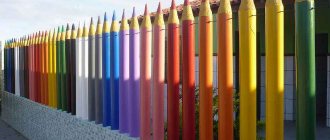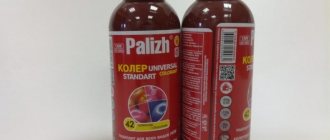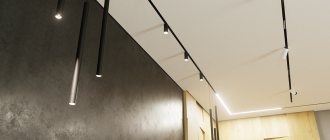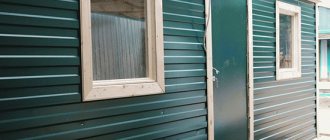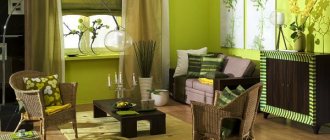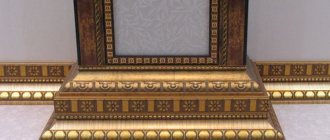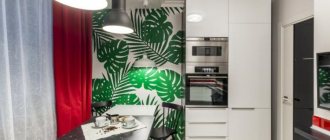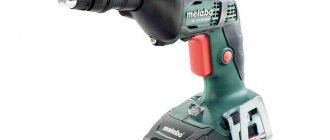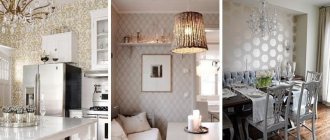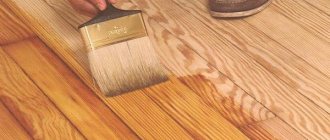The colors of the corrugated fence and the house do not necessarily have to match in color intensity, but they must be in harmony with each other. The catastrophic tonal discrepancy between the color of the fence and the façade looking through it doesn’t just hurt the eye. It causes confusion among neighbors and passers-by and has an irritating effect on the psyche of the person living in the house.
Beautiful suburban residential building
Modern psychology recommends choosing not just shades that are in harmony with each other, but also taking into account their influence on the subconscious. In landscape design, the colors of the fence and the house determine the stylistic and natural harmony of the structure.
What determines the choice of fencing color?
Painting a fence near a house or in a country house is not so easy. Building design sometimes gives instructions that contradict the wishes of the residents themselves or the rules of territory design according to Feng Shui. The situation is complicated by the presence of a huge assortment of paints for wooden and metal structures, so without special knowledge you can get confused. To find the best color, before painting you should carefully study the factors influencing this choice:
- background of house elements - roof, walls, window frames, veranda and porch;
- home style;
- color schemes on the site, shades of additional buildings, structures, structures;
- amount of green space;
- colors of fences in neighboring areas.
Taking these factors into account, you need to decide on the main goal: whether the fence will blend into the landscape, get lost, be discreet, or, on the contrary, you want to highlight it, make it bright and unusual. For the first option, it is better to paint the gate and the fence itself in the same color scheme as the facades. You can also use a color close to the shade of the roof, which often serves as the base for the design of the entire area. The second design option involves an interesting contrasting combination of colors: for example, a chocolate fence for a turquoise or blue house.
How to paint a fence: wooden, concrete, metal, 30 photos - catalog of articles on the site
Building a House
- Construction Preparation
- Foundation
- Floor
- Walls and partitions
- Roof and ceiling
- Windows and accessories
- Doors
- DIY insulation
- DIY facades
- Articles about stairs
- Articles about construction varnishes, paints and adhesives
- Articles about plasters and dry mixes
- How to choose equipment and power tools for construction?
- How to choose finishing materials?
- Articles about drywall
- Country house
- Repair
- Do-it-yourself heating of a private house
- Interior in the office
- Finishing
- Bathroom finishing
- Buildings in the landscape
- Do-it-yourself brownies
- Furniture on the balcony
- Bedroom decoration
- Furniture in the hallway
www.domstoy.ru
Fencing for the site: selection of material and shade
The color of the fence needs to be planned depending on the material of manufacture. Each of them has a number of advantages and disadvantages regarding operation and paintability.
Wooden fence
A wooden fence is a classic of the genre that will never become outdated. To make a picket fence, no special knowledge is required; it is easy to make with your own hands, embodying any idea. The easiest way is to buy ready-made sections of the required height and width that are already fastened with wooden planks. On sale there is a simple fence and a 3D picket fence with convex elements.
You can also make a wooden fence yourself from uncut or sanded boards, lining, bars, give them any shape and paint them in the desired color. Typically, connoisseurs of naturalness choose simple varnishing of wood so as not to cover its natural shade. In addition, the wood is covered with stain and then varnished: in this way, the cheapest species can be “transformed” into an elite one.
It is recommended to paint the wooden fence in accordance with the colors of the other elements. The color of aqua, green, and light green goes well with wood. White, beige and other light shades should not be used, or several coats will be required to cover the natural wood tone. The disadvantages of a wooden fence include rotting, short service life (up to 15 years), and the need for constant maintenance and painting. For greater reliability, you can combine wood with concrete and stone.
Fence made of corrugated sheets
Profiles, corrugated sheets, and profiled sheets are excellent materials for making fences, as well as sliding and drive-out gates. Such fences are increasingly being installed in summer cottages, because they are very durable, do not react to external factors, are durable, and protect from prying eyes and noise. Caring for the material is very simple: it is easy to repair and paint.
A fence made of corrugated sheets also has disadvantages. It is ugly on the inside, and on the outside it does not provide the opportunity to organize a unique, unusual design for the site. However, there are ways to solve this problem: a corrugated fence can be combined with brickwork, concrete pillars, and colored mesh. In addition, modern corrugated sheeting with a polymer or zinc coating can be either plain or imitate brick, masonry and even wood.
What shade to choose for a fence made of corrugated sheets? It looks best in these colors:
- brown;
- chocolate;
- blue;
- Ivory;
- green.
Against the background of white wall facades, a cherry-colored fence looks attractive, and a beige fence is suitable for the masonry of the house.
Metal profile fence
A fence made of metal profiles or European picket fences also has a long service life, greater reliability, and is more aesthetically pleasing. A Euro picket fence, for example, imitates a fence made of natural wood and is combined with brick posts. Lamellas made of galvanized steel do not fade, are very durable, and can be installed in a simple or staggered manner. For such a fence, light shades are usually chosen: blue, green, white, beige, light gray, although it all depends on a successful combination with the color of the roof and the house.
Treating wood surfaces in winter
If the need to protect a wooden fence arose in winter, the choice of means will be limited. Paints such as styrene-acrylic or latex are suitable. They are resistant to low temperatures.
But the order of application is somewhat unusual:
- Half of the paint is mixed right outside.
- The second part is in a warm room.
This combination of solution temperatures, according to manufacturers, ensures strong adhesion of the paintwork to wood.
Color combination of fence and facade
The shade of the fence sets the general direction of the design of the site, because it is the fence that first meets a person when approaching the house. The classic rule for selecting the shade of a fence is: “dark top – light bottom.” This solution is considered traditional, so a dark-colored roof and fence in combination with a light facade are used by designers quite often. You can make all the main elements (facades, roof, fence) dark, while choosing the finishing (windows, doors, veranda, gates, drainage system) in light colors.
When designing a site, style plays an important role. So, for a country-style home, a fence made of natural-colored wood coated with stain (oak, walnut, cherry and others) is ideal. For a castle-style house, it is worth choosing fences made of natural stone and brick.
Preparing for coloring
Painting a concrete fence begins with cleaning the structure from any dirt and old paintwork. To do this, sections are generously moistened with soapy water, left for 15-20 minutes and cleaned with a stiff brush. After this, the fence is washed with water and allowed to dry.
Old paintwork is removed with special paint removers.
Metal elements are cleaned of rust and treated with an anti-corrosion compound. If there are cracks in the concrete surface, you need to cover up the flaws with ordinary cement mortar. To prepare, take sand and cement in a ratio of 3:1 and dilute the mixture with water. Cracks are covered with a spatula or trowel. The prepared surface must be primed. Primer Process Requirements:
- Paints and primers should be of the same type and preferably made by the same manufacturer.
- A water-based primer is used for surfaces that have not previously been painted;
- Organic-based soil is used for deep impregnation of a fence made of low-grade concrete.
- The primer must be applied to the front and back sides of the fence using a roller or brush.
- Painting is performed after the impregnation has dried. Drying time varies from 12 to 24 hours - depending on the composition.
- Organic primers can be applied at sub-zero temperatures, except for polyurethane primers.
- Water-based compositions are well absorbed into the concrete base at high air humidity.
To ensure that nothing interferes with the priming and painting process, plants planted near the fence are carefully tied up, and if possible, decorative elements decorating the garden plot - sculptures, benches, small architectural forms - are removed. The strength and durability of the paint and varnish coating depends on the quality of the primer, so you should not skimp on impregnation compounds.
On video: how to beautifully paint and tint a concrete fence.
Which color is easier to care for?
Many people mistakenly believe that a gray fence or a black fence is ideal in terms of cleanliness: they hardly get dirty, and dirt is not visible on them. In reality this is not the case. On a dark fence, street dust is very noticeable, especially drops of dirt after rain, when they dry out. Dried streaks of water are noticeable on the metal surface, giving the fence an unaesthetic appearance. Of course, dirt will also be visible on a white or beige fence, even small spots.
The easiest to maintain is considered to be a green and brown fence in any shade of these colors. The dirt on it is less noticeable, but you still have to wash it periodically. Therefore, it is better to choose a material for the fence that is easily cleaned with a stream of water from a hose and does not deteriorate from regular washing.
Features of painting an old fence
The old fence is painted in the same way as the new one. With the exception of preparation - here it must be thorough.
Old paint is removed with a brush or metal paper. There are solvents that are applied to a rag and wiped off the dried paint. All processes are performed using rubber gloves. If some of the boards are eaten by insects, then it is better to replace them.
Old varnish is removed in the same way. The cracks are primed and puttied. Afterwards the fence is painted.
The choice of product is individual. The main condition is high-quality protection of treated wood for decades without losing its attractive appearance.
What fence color to choose according to Feng Shui
To ensure harmony and arrangement of the courtyard, it is worth painting all the main elements in accordance with Feng Shui recommendations. As for the fence, the Taoist practice of designing space advises starting with it, because it is the first barrier, protection from the outside world and negative energy.
Feng Shui believes that a fence attracts different types of energy forces, so the mood in the family, the number of conflicts, and harmony in the house will depend on its color. It is worth considering the main colors for fences to understand their impact on residents.
Black
You should not paint the fence black; it will provide the area with a gloomy, oppressive atmosphere. By constantly contemplating the fence, a person himself reduces the amount of positive Chi energy, while increasing the negative influence of bad Chi energy.
White
From a practical point of view, a white fence is also not a good option. Of course, it symbolizes purity and tenderness, but in relation to energy it represents vacuum and death. The abundance of white color leads to depletion of the energy forces of household members.
Blue
A blue fence slightly reduces a person’s strength and energy activity, as it brings an atmosphere of relaxation. You can use blue to paint a fence only if a person needs calmness, a reduction in the feeling of chaos, or too violent energy.
Violet
This color is a symbol of greatness and excellent mental abilities. It is great for painting hedges and increases the flow of positive Qi energy.
Green
Green is ideal for south-facing fences and also looks great on the inside of the fence. It gives harmony and tranquility to the entire area, and triggers a restorative function. Green will outline the area like a hedge and enhance the feeling of closeness to nature. Experts especially advise using it where there is a shortage of bushes and trees.
Yellow
Bright yellow color can cause aggressive behavior, irritability, anger, as it carries masculine Yang energy. But soft shades of yellow and golden tones will give cheerfulness and optimism; they are perfect for decorating a site.
Red
This color is the most powerful, according to Feng Shui. It must be used with great caution, since in significant quantities it carries aggression and anger. In muted, dusty tones, red is still suitable for painting a fence, unlike fiery, purple, and crimson colors. In addition, irritable people should not use any shade of red for the inside of the fence. You can combine red with green, because the latter will restore the strength of the residents and reduce the risk of discord in family relationships.
Brown
This color is the leader among those used for painting fences, because, from a design point of view, it is ideal. According to Feng Shui, it is also considered suitable for painting a fence, but only for those located on the east and southeast sides. In this case, brown will reflect wealth, abundance, good reputation and luck of the person.
Choosing the main shade for a fence on your own, taking into account a lot of data and influencing factors may seem difficult. And yet, this can be done, guided by useful information and your own preferences, then the site will only cause joy and a feeling of harmony!
Adviсe
If you need to choose a brand of concrete to create monolithic slabs, you need to choose the best quality product. Check whether reinforcing parts will be used as part of the future structure, because this plays a role in the choice of concrete. Thus, most often the choice is on the M250-350 brands. When installing a fence at a private home yourself, it is best to entrust the choice of solution to an experienced specialist. If the fence does not require a solid foundation, you can choose a lightweight type of concrete that will cost you the least.
How to install a concrete fence yourself, see below.
Modernization with vegetation
Floral design is suitable for all types of fences and will give new life to an old structure. Decorating a simple fence will not require large expenses, but will give it a presentable, animated feel. You can green your garden frame using several types of plants:
- climbing perennials. Flowers are not picky about weather conditions, grow quickly in shady areas and are practically not exposed to pests. Among them are ivy, virgin grapes, varieties of honeysuckle, hop vines, and roses.
- climbing annuals. Their use allows you to change the scenery every year. Seasonal varieties need warm and moist soil. A riot of flowers delights from mid-spring to late autumn. You can show your imagination by combining peas, morning glory, nasturtium, decorative beans, hyacinth beans, which will effectively frame a wooden fence.
- flower beds. An ideal tandem consists of plants with different life cycles. Decorations in the form of a solid multi-colored stripe can disguise the imperfections of the fence. Delphiniums, hollyhocks, and rudbecks will help create an impeccable look.
Properly selected plants for climatic conditions can not only please the eye and saturate the air with a fragrant aroma, they will bring harmony to the overall design of the summer cottage.
Choosing a manufacturer
Caparol
The paint and varnish coatings of this company are of high quality, thanks to which Caparol is a leader in the façade paint market in Austria and Germany. The most popular paints of this company are:
- AmphiSilan Plus - this type of paint has excellent water-repellent properties, but does not form a film on the painted surface;
- Disbocret 518 Flex-Finish, Disbocret 515 BetonFarbe - mask surface damage and protect against harmful substances;
- Alpina MegaMax Universal is a universal type of paint that is very resistant to external harmful factors and has a matte effect;
- Amphibolin is a paint with a matting effect and high adhesion;
- Amphibolin is a coating that prevents the formation of moss and fungi, and is also characterized by low vapor permeability, good water-repellent properties and high wear resistance.
KrasByt
The paints from this company are easy to apply, have high quality and an affordable price. The most popular:
- Aquapolymerdecor is an epoxy primer-enamel with a water-dispersion base. It can be applied to the surface without pre-impregnation;
- Betil is an enamel with high wear resistance. To dilute betyle use: white spirit, butyl acetate or solvent;
- Aquabetol is an environmentally friendly acrylic paint that can be diluted to the desired consistency with ordinary water;
- Polymerdecor – polyurethane enamel, resistant to wear and chemical compounds;
- Betylate is an acrylic paint that can be diluted with butyl acetate or white spirit.
Other manufacturers
Among other manufacturers, the following popular paints can be distinguished:
- Siloxane façade (Teknos, Finland) is a silicone enamel with a mineral base. It protects the surface from moisture, but at the same time allows it to “breathe”;
- Novasil is a water-based enamel with an acrylate base;
- Kivitex (Tikkurila, Finland) – a paint based on liquid potassium glass and having a matte effect;
- Teknos SAKU is an acrylic paint with a water-dispersion base.
Nuances and subtleties of painting work
- Before starting work, the wood must be treated with an antiseptic. This will protect wood flooring from bacteria that can cause damage to this material;
- By impregnating with drying oil, you can increase the service life of the fence much longer than without it;
- When painting the fence, you should work from top to bottom, which will help avoid drips. This is also true for painting a concrete fence;
- When working with wood, you should use brushes that will provide the best and most reliable coverage of each fence board. If you need to reduce the painting time, use a wide brush that can grip several boards at the same time;
- When painting the lower part of the fence with a brush, place a board under it, which will help prevent dirt from getting on the fresh paint;
- All work should be carried out on days with low temperatures, preferably without direct sunlight.
Painting brick pillars
Paint used for finishing brick fence posts
Such a fence is a symbol of respectability, prudence and self-confidence. Such a structure on a good foundation will serve its owner for many years. Made from facing bricks, such a fence does not require serious attention for many years. When the need to paint it nevertheless arises, the following steps should be taken:
- You can start painting the brick surface no earlier than one year after construction. Brick, being a porous and breathable material, must dry completely and gain all its characteristic properties.
- All efflorescence and other defects that have appeared during this time must be thoroughly cleaned with a wire brush. Significant defects should be plastered.
- Deep efflorescence that cannot be removed with a metal brush must be soaked with ammonia or 5% acetic acid and brushed again.
- If there is mold or similar contaminants, soak in a chlorine solution and clean with a brush. Let dry for several days.
- Impregnate the brick pillar with a water repellent similar to “Tiprom U”, “Lepta Himfrez”, “Wepost Luxe”, to give the material water-repellent properties and vapor permeability.
- Allow to dry according to the impregnation manufacturer's recommendations.
Brick paint options for exterior use:
If you follow all the recommended procedures, you can easily verify their simplicity and simplicity. The result obtained, associated with the appearance and ease of further maintenance of the masonry, will surprise you for many years to come. Spring and autumn washing of masonry using a Karcher household pump under low pressure will not be difficult.
https://youtube.com/watch?v=rRVKwJ8GyuE
Creating an entrance
The fence gate should not be located opposite the doors. This is considered a bad sign in Feng Shui: the energy will “walk”, as if in a draft. How to login correctly:
- It’s also not a good idea to place the entrance to the area behind the building: it’s ideal to place it at an angle so that the gate can be seen from the entrance doors.
- The gate should be medium in size: an entrance that is too wide or narrow interferes with the movement of energy.
Article on the topic: How to build a bathhouse with a relaxation room
The shape chosen is rainbow-like (round). Sharp corners in the teaching are considered too rough, while rounded ones soften the flow of energy to the site and into the house.
Bells or jingling coins are hung above the gate. This way the wind will bring wealth to the site. If the house is located near a road or highway, the front entrance is moved further away and fenced off with green spaces.
